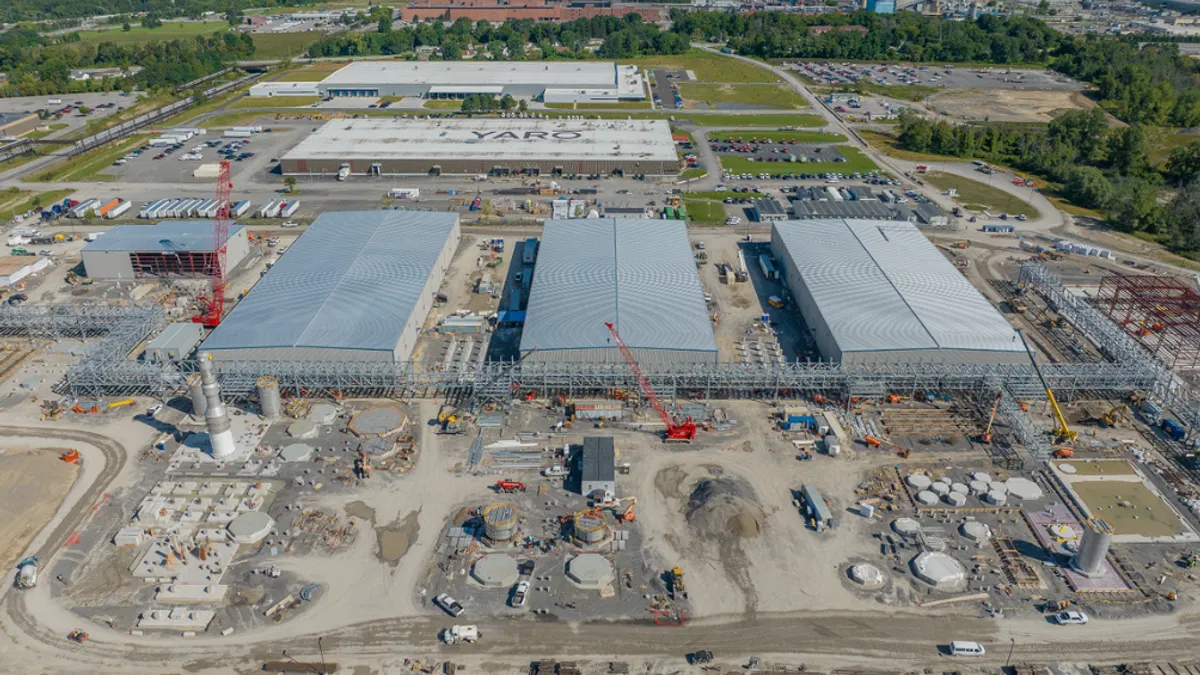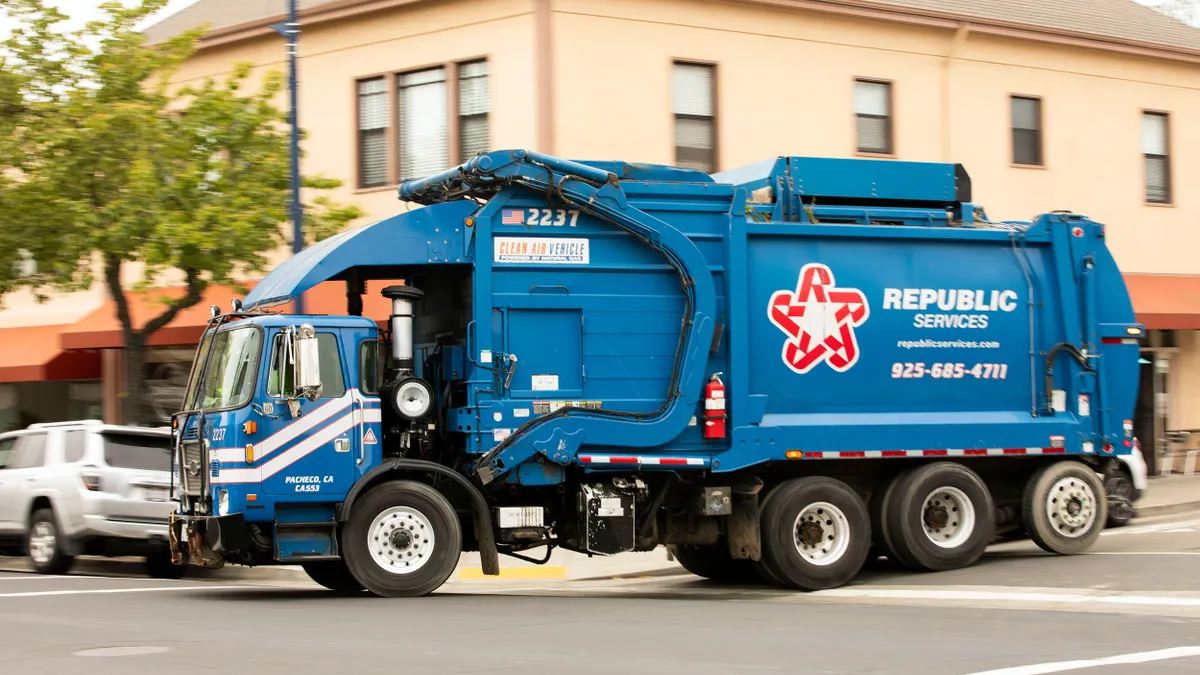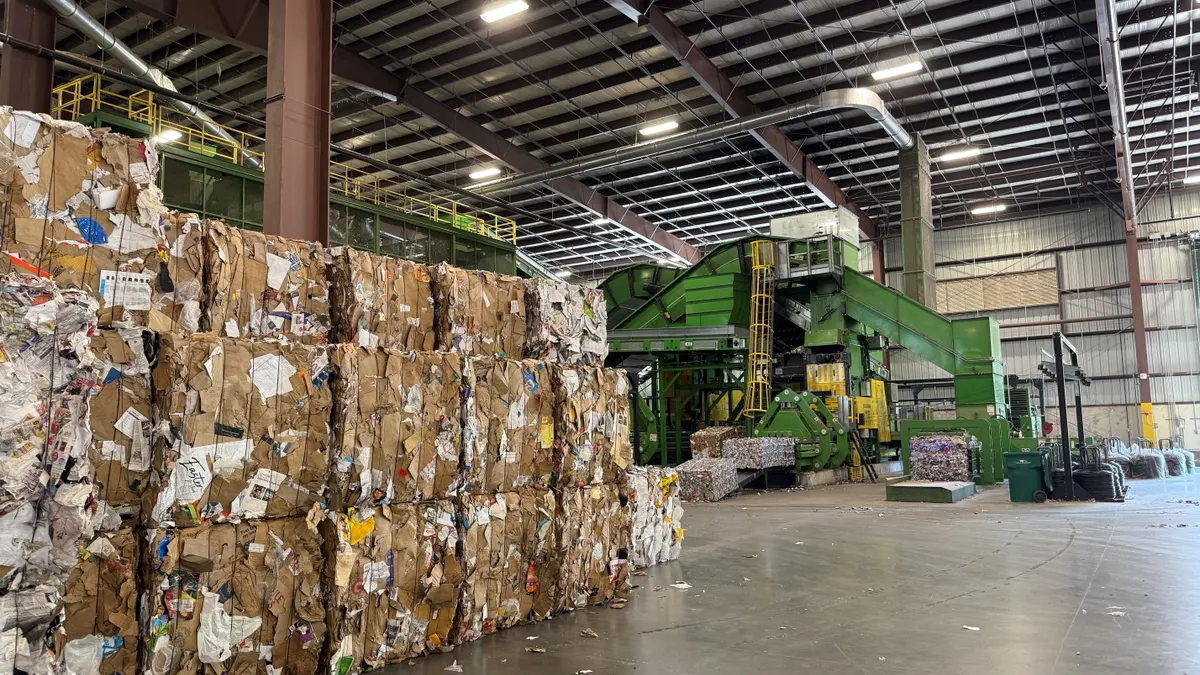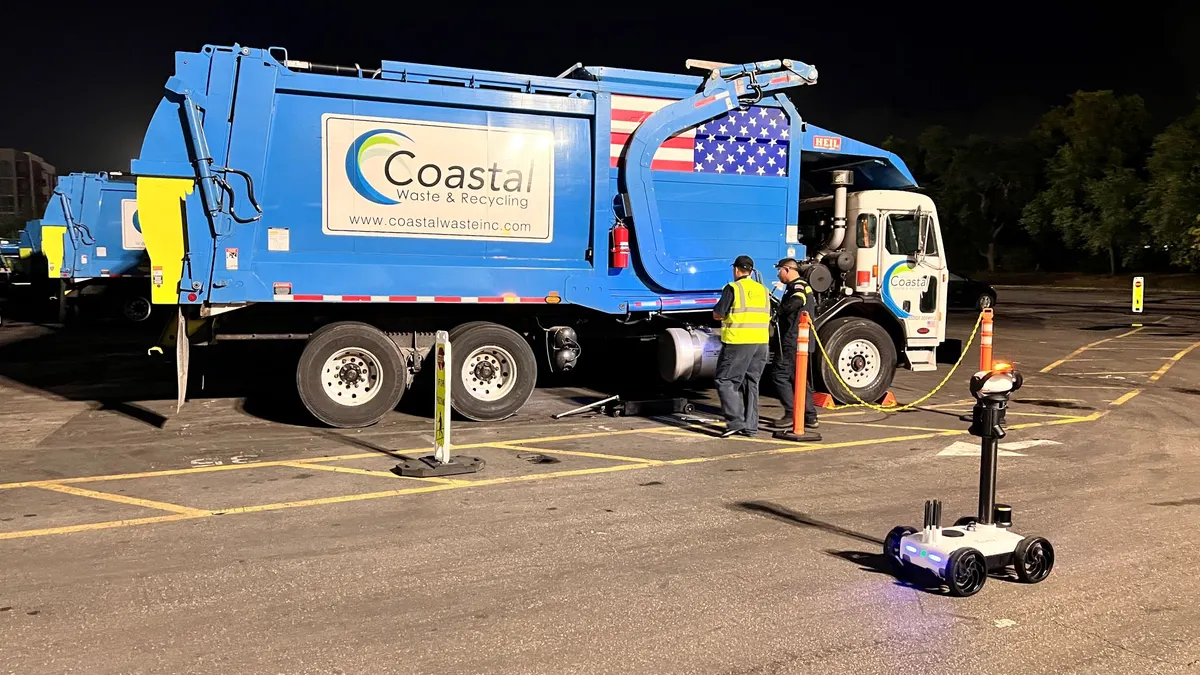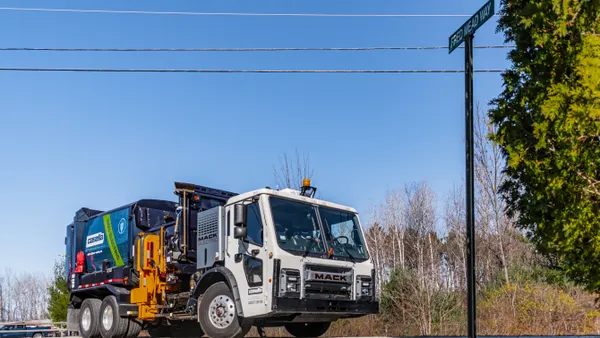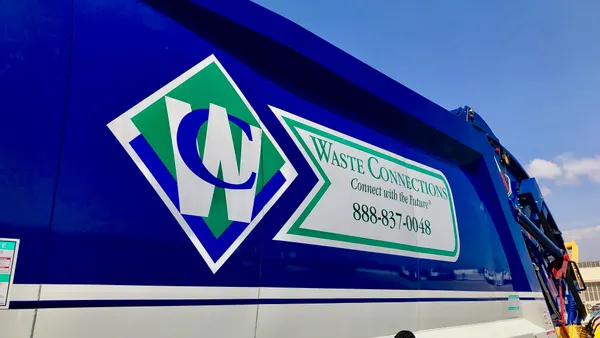After nearly four decades spent working for Waste Management around the country, COO Jim Trevathan is set to wrap up a fruitful career next month in Houston, where he first got his start in the industry. Few other national executives have been on the job as long or have seen such radical change at the international level.
Before becoming COO in 2012, Trevathan served as executive vice president, senior vice president of multiple regions, and many other roles in a career that began back in 1979. His current portfolio includes field operations, sales and marketing, national strategy and account management, business development and acquisitions, and price management. Trevathan will be succeeded by John Morris in 2019.
After leaving the C-suite, Trevathan plans to help his wife grow her charitable foundation and spend more time with his grandchildren. Waste Dive had the opportunity to talk to Trevathan last month about his career highlights, current industry trends and where it may all be headed in the decades to come.
The following interview has been edited for brevity, clarity and context.
WASTE DIVE: How does the Waste Management of today resemble Waste Management in 1979?
JIM TREVATHAN: Different colors, different logo, different leadership — but to be honest, it's the same business from a core perspective. We still pick up the smallest commercial location — a restaurant, or a dry cleaner, or a small business with one location — and then we still touch some of the big national, multi-location chains that are Fortune 10, 50 companies with basically similar service, but in thousands and thousands of locations. We did that then, and we do that now.
Although, at that time most of our national customers had not consolidated their purchasing strength. So I got to be part of when we started the national accounts department. We saw and helped some of those large concerns that have hundreds or thousands of locations put together a package and do a common service across the nation, or across North America. It was exciting times then, and that's basically done now.
Obviously, strategy has changed some on how we're going to drive shareholder value. At that time we were primarily a roll-up. We were buying mom and pop, small haulers all over North America, and landfills and recycling facilities. And that's where most of the growth came from.
Today, our growth still comes partially from the M&A activity. But here in the last few years it's come through organic growth, through new business start-ups, and getting much better at finding ways to focus on new businesses, and get them to be part of our customer base before they even need the service. There are all kinds of services that we've found that'll let us target that business during the construction phase. Play a role in helping them handle their debris from the construction of the new business and then be a permanent service for them as well. So we've got a lot more organic growth today than we did then.
You've also seen some big changes along the way in terms of mergers, the 1998 USA Waste deal being among the largest. How did that affect company culture?
TREVATHAN: You're bringing back interesting memories. Some good and some real bad.
USA Waste was about a $2 billion, maybe $3 billion company, and we were over $10 billion. When the [smaller company's] culture takes over, that's disruptive, to say the least. Not all bad, but a very accountable organization. Still a lot of focus on M&A activity at the time. Much less than we had in Waste Management on operational improvements, and consistency of operation across the country. They were more focused on "how do we grow this business through that M&A activity?" And of course, when you merge those two companies, "how do we get the synergy value from merging two large companies?"
[We moved] the corporate office, that's why we're sitting here today in Houston. Our corporate offices were in a suburb of Chicago, Oak Brook, and then moved here. This building was USA's corporate office.
Then of course the management team, through illness, as well as just reorg, didn't really last past a year. John Drury, unfortunately, found out he had cancer a few months after the acquisition was completed, and passed away. So that, I'm sure, affected things, because John was a very, very smart gentleman. He'd been part of the old BFI organization, so he knew his way around this business, and just didn't get the time, unfortunately, to execute on that knowledge.
Drury officially stepped down in 1999 and died of brain cancer in 2000. After further executive shake-ups, Maury Myers came on as CEO. Trevathan had joined the senior leadership team following the USA Waste merger and Myers kept him at that level.
[Maury] had been at Yellow Freight, Aloha Air Group, America West Airlines. A great track record in transportation, primarily, but he had a great experience base with Wall Street. They trusted him, and we needed that, because those promises of synergy value from the culmination of those two companies didn't quite come to fruition. So they needed someone to come in and say, "This is what we can do, and we will do it, quarter in and quarter out." Maury brought that stability. He also brought a customer focus that I don't think the previous management team had to the same extent.
We rolled out — I got to be part of it, and lead the effort — what we called "service machine." It was just a culture around how to service our customers at the very front line, in a consistent manner, but from their perspective. Not just from our operating perspective, but what does the customer want?
That wasn't a common theme in our industry. We were in a growth mode of M&A activity, so it was a great focus on how do we service our customers and create a value so that they stay with us longer?
You talk about culture change, Maury stayed five years, a great five years, and brought real stability to the company. He used to say when he first came, his task was to get the truck out of the ditch. We had some struggles there during that culmination of those two companies, and he came in and got the truck out of the ditch. I used to kid him, though, about an unusual truck in the ditch with mid-20s EBITDA margins. It's not like we weren't profitable, it wasn't like we were struggling to make payroll. This is a very profitable business, and was then, but there was much more upside that he brought that we could move those margins forward and create consistency with shareholders that they appreciated.
Dave Steiner came [in 2004] and continued that same focus on customer, but added a real price focus. How do we price our services to get the most shareholder value, and yet still maintain a retention of those most profitable customers? The last thing we want to do is turn them over with just a broad brush price change. So we were much more selective in how we did it, but we were also much more aggressive in rolling out price increases. At least enough to cover our cost increases. Dave was a visionary leader that really added value in that regard especially.
Jim Fish just followed him [in 2016]. We have not changed from that [culture], whether it's pricing, whether it's service to customers, but Jim has added a people focus. Let's look at leadership development within our company for the long-term, but let's also look at, how do we make sure that our drivers and technicians, and those frontline employees, and their frontline management teams are progressing at the right level? Let's make sure people are a real focus. And I can't say that was always the case.
Jim is, from the very top of the company, driving a real personal aspect to the business that I think will serve this industry, and our company, and our shareholders for a long time. At the same time, Jim's bringing a clearer vision around how do we add technology and move our business.
How do we add technology to our operating teams that help us route trucks much better than before? How do we add safety? If I added one thing dramatically different about our company, that I've gotten to be a part of and help lead, is the safety culture. In the '80s and '90s it's not that we weren't safe, it's not that we didn't look at safety metrics, but it was not a core value that we drove through the organization, and required us to help each other to make sure I'm holding you accountable, and you're holding me accountable for safe actions.
Trevathan goes on to discuss installing cameras in all of Waste Management's trucks as an example of a difficult culture change, but one that he feels has been successful as a coaching tool to help make drivers safer.
That culture change, though, needs to be led. With 450 hauling companies, you just don't roll it out and they all jump on and say, "Bring it." You have to roll it out and do it in the right way. It creates a leadership tool that people at the front line, all the way to the CEO see value, and hopefully shareholders.
Is this type of tight labor market rare in your tenure? Have you seen this type of low unemployment rate before?
TREVATHAN: Probably not at this employment rate, but we're still able to find drivers. There's no doubt in the last, especially six months, there's some inflationary pressures for drivers and technicians unlike previous periods. That's not dramatic and out of scope, and it's not that we're not able to handle it — but it's putting some margin pressure that we're going to have to find better ways to overcome as we move forward into future quarters, and we will.
How do we go to customers and show them that this is the market that we're in today, and it's required to service you? And as it broadens across all transportation entities, I think you'll see it be a common practice from a shareholder perspective, we're going to provide a safe driver, at a fair pay, but then get that pay back from our customers.
[But] not many people — drivers, technicians, business analysts, or the media — leave strictly because of pay. How do we create a best place to work? How do we create value from the green and gold? How do we make sure that they see that, and they feel it, and we take steps so that it not only helps their checkbook, but also helps their working condition?
Waste Management will be giving $2,000 bonuses to an estimated 34,000 employees at the end of this year and has also rolled out a training program for district and route managers to help improve retention. Trevathan also discussed plans to try and create four- or five-day work weeks in select markets, along with more flexible scheduling patterns, to attract more young people. He said the company is also looking at pilots to centralize its maintenance program in markets such as Houston and Los Angeles to help create more day-time schedules for a technician force that often works evenings and nights.
Our transfer stations where we haul waste longer distances, that's where most of the pressure has come from. Most of that's third-party, but it's hard for our third-party company partners to find drivers to move that volume longer distances, because of the impact across North America to close-to-full or full employment in the transportation job sectors.
When asked about attracting younger recruits to the industry, Trevathan talks about a new remote-operated bulldozer pilot for one of the company's landfills that was announced over the summer. This has been touted as way to potentially attract a new pool of candidates – including veterans. While Trevathan said he didn't expect to see driverless collection vehicles on the streets any time soon, he pointed out that driver-operated automated collection vehicles have helped significantly.
On the residential side, one of the hardest and the highest turnover rates occur for residential service is where you still have helpers on the back of the truck, and not an automated lift system. We're moving as fast as we can to get our customers to automated only. Now, that'll take a few years as well. Some neighborhoods, or small towns, or large cities prefer that method, but it adds the risk component, the safety issues, and more potential for injury or harm to those helpers and drivers.
With automated residential service, we're at about 61% or 62%. Every percent is pure dollars to the bottom line as we move to automation.
Click here to read the second half of Waste Dive's exclusive interview with Jim Trevathan about the evolution of recycling, landfills, consolidation and potential future alternatives in the decades to come.







